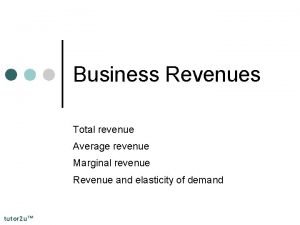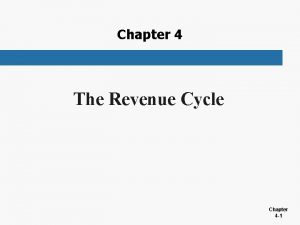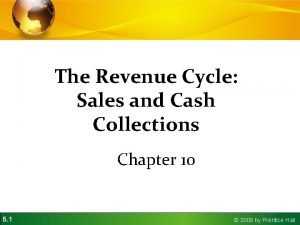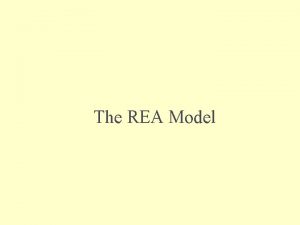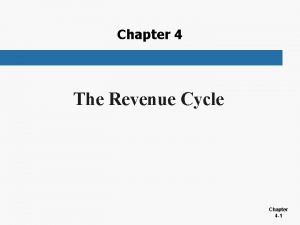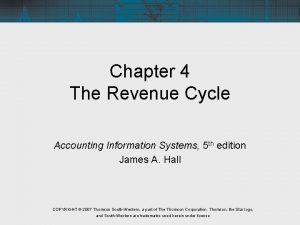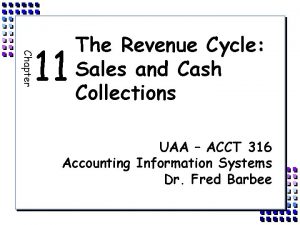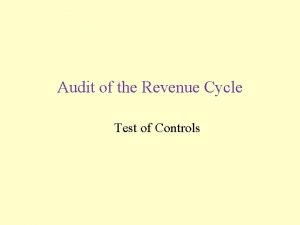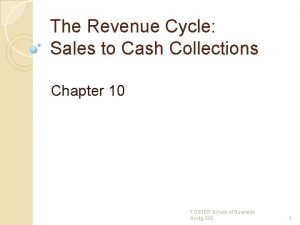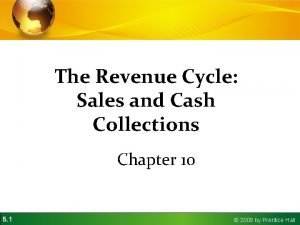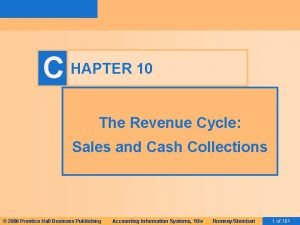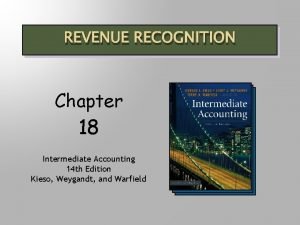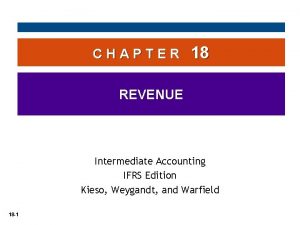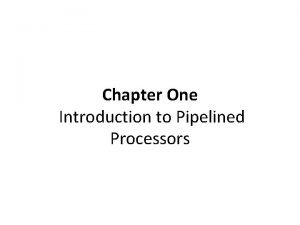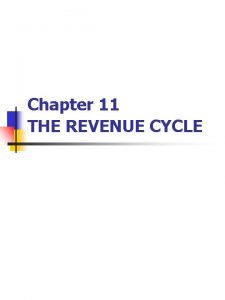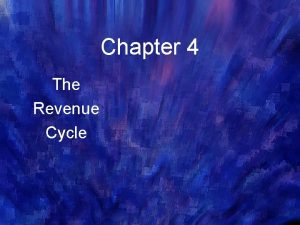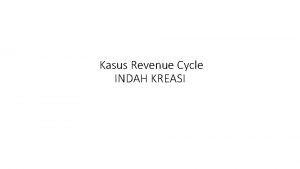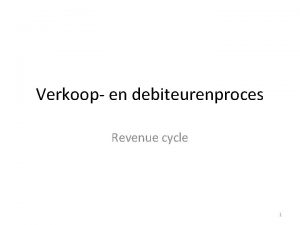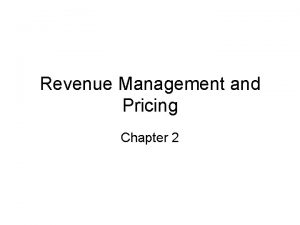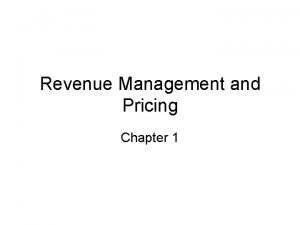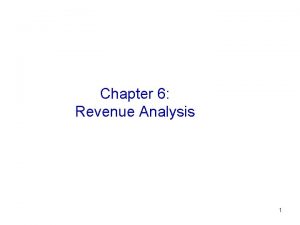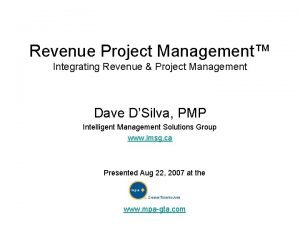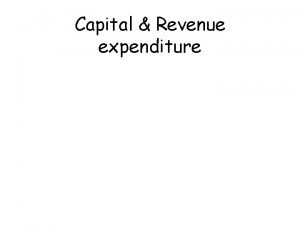Chapter 4 The Revenue Cycle Chapter 4 1








































































- Slides: 72

Chapter 4 The Revenue Cycle Chapter 4 -1

Revenue Cycle we examine the revenue cycle conceptually, Using data flow diagrams (DFDs) revenue cycle includes: sales order procedures, sales return procedures, and cash receipts procedures Chapter 4 -2

Salse Order Procedures/Conceptual System Receive Order. Ø The sales process begins with the receipt of a customer order indicating the type and quantity of merchandise desired. Ø Because the customer order is not in the standard format the seller’s order processing system needs, the first task is to transcribe it into a formal sales order Ø The sales order captures vital information such as the customer’s name, address, and account number; the name, number, and description of the items sold; and the quantities and unit prices of each item sold. Ø After creating the sales order, a copy of it is placed in the Chapter customer open order file for future reference 4 -3

Salse Order Procedures/Conceptual System Receive Order. The customer record in the open order file is updated each time the status of the order changes such as credit approval, on back-order, and shipment. The open order file thus enables customer service employees to respond promptly and accurately to customer questions Chapter 4 -4

Salse Order Procedures/Conceptual System Check Credit Ø The credit approval process is an authorization control and should be performed as a function separate from the sales activity Ø The receive-order task sends the sales order (credit copy) to the check-credit task for approval. Ø The returned approved sales order then triggers the continuation of the sales process by releasing sales order information simultaneously to various tasks Chapter 4 -5

Salse Order Procedures/Conceptual System Pick Goods. Ø The receive order activity forwards the stock release document (also called the picking ticket) to the pick goods function, in the warehouse. Ø This document identifies the items of inventory that must be located and picked from the warehouse shelves. Ø It also provides formal authorization for warehouse personnel to release the specified items � Ø After picking the stock, the order is verified for accuracy and the goods and verified stock release document are sent to the ship goods task Chapter 4 -6

Salse Order Procedures/Conceptual System Pick Goods. Ø Ø If inventory levels are insufficient to fill the order, a warehouse employee adjusts the verified stock release to reflect the amount actually going to the customer. The employee then prepares a back-order record, which stays on file until the inventories arrive from the supplier The warehouse employee adjusts the stock records to reflect the reduction in inventory. These stock records are not the formal accounting records for controlling inventory assets. They are used for warehouse Chapter management purposes only 4 -7

Salse Order Procedures/Conceptual System Ship Goods. Ø Ø The shipping department receives the packing slip and shipping notice from the receive order function. The packing slip will ultimately travel with the goods to the customer to describe the contents of the order. The shipping notice will later be forwarded to the billing function as evidence that the customer’s order was filled and shipped The shipping clerk reconciles the physical items with the stock release, the packing slip, and the shipping notice to verify that the order is correct Chapter 4 -8

Salse Order Procedures/Conceptual System Ship Goods. Ø Ø Ø The shipping clerk packages the goods, attaches the packing slip, completes the shipping notice, and prepares a bill of lading. Bill of lading is a formal contract between the seller and the shipping company (carrier) to transport the goods to the customer Once the goods are transferred to the carrier, the shipping clerk records the shipment in the shipping log, forwards the shipping notice to the bill customer function as proof of shipment, and updates the customer’s open order file Chapter 4 -9

Salse Order Procedures/Conceptual System Bill Customer Ø The shipment of goods marks the completion of the economic event and the point at which the customer should be billed Ø When the customer order is originally prepared, some details such as inventory availability, prices, and shipping charges may not be known with certainty Ø To prevent such problems, the billing function awaits notification from shipping before it bills Ø Upon credit approval, the bill-customer function receives the sales order (invoice copy) from the receive order task. This document is placed in a sales order pending file until receipt of the shipping notice, which describes the products that were Chapter 4 -10 actually shipped to the customer

Salse Order Procedures/Conceptual System Bill Customer Ø The completed sales invoice is the customer’s bill Ø The billing function performs the following record keeping –related tasks: 1. Records the sale in the sales journal. 2. Forwards the ledger copy of the sales order to the update accounts receivable task 3. Sends the stock release document to the update inventory records task. Chapter 4 -11

Salse Order Procedures/Conceptual System Ø The sales journal is a special journal used for recording completed sales transactions. Ø The details of sales invoices are entered in the journal individually. Ø At the end of the period, these entries are summarized into a sales journal voucher, which is sent to the general ledger task for posting to the following accounts Accounts Receivable Sales DR CR Chapter 4 -12

Salse Order Procedures/Conceptual System Chapter 4 -13

Salse Order Procedures/Conceptual System Update Inventory Records Ø The inventory control function updates inventory subsidiary ledger accounts from information contained in the stock release document. Ø the financial value of the total reduction in inventory is summarized in a journal voucher and sent to the general ledger function Update Accounts Receivable. Ø Ø Customer records in the accounts receivable (AR) subsidi- ary ledger are updated from information the sales order (ledger copy) provides. the individual account balances are summarized in a report that is sent to the general ledger. Chapter 4 -14

DFD of Sales Order Process Chapter 4 -15

Salse Order Procedures/Conceptual System Post to General Ledger Billing, A/R, and Inventory Control submits summary information to the General Ledger dept Chapter 4 -16

Sales Return Procedures Chapter 4 -17

Sales Return Procedures/ Conceptual System Ø The company shipped the customer the wrong merchandise. Ø The goods were defective. Ø The product was damaged in shipment. Ø The buyer refused delivery because the seller shipped the goods too late or they were delayed in transit. Chapter 4 -18

Sales Return Procedures/ Conceptual System Prepare Return Slip Ø When items are returned, the receiving department employee counts, inspects, and prepares a return slip describing the items. Ø The goods, along with a copy of the return slip, go to the warehouse to be restocked. Ø The employee then sends the second copy of the return slip to the sales function to prepare a credit memo. Chapter 4 -19

Sales Return Procedures/ Conceptual System Prepare Credit Memo Ø The sales employee prepares a credit memo. Ø This document is the authorization for the customer to receive credit for the merchandise returned. Ø if the clerk has sufficient general authority to approve the return, the credit memo is sent directly to the billing function, where the customer sales transaction is reversed. APPROVE CREDIT MEMO. Ø The credit manager evaluates the circumstances of the return and makes a judgment to grant (or disapprove) credit. Ø The manager then returns the approved credit memo to the Chapter sales 4 -20 department.

Sales Return Procedures/ Conceptual System Update Sales Journal Ø Upon receipt of the approved credit memo, the transaction is recorded in the sales journal as a contra entry. Ø The credit memo is then forwarded to the inventory control function for posting. Ø At the end of the period, total sales returns are summarized in a journal voucher and sent to the general ledger department. Chapter 4 -21

Sales Return Procedures/ Conceptual System Update Inventory And Ar Records. Ø The inventory control function adjusts the inventory records and forwards the credit memo to accounts receivable, where the customer’s account is also adjusted. Ø Accounts receivable submits an AR account summary to the general ledger function. Chapter 4 -22

Sales Return Procedures/ Conceptual System UPDATE GENERAL LEDGER. Upon receipt of the journal voucher and account summary information, the general ledger function reconciles the figures and posts to the following control accounts: Chapter 4 -23

Cash Receipts Procedures/ Conceptual System Open Mail And Prepare Remittance Advice Ø Ø A mail room employee opens envelopes containing customers’ payments and remittance advices. Remittance advices include payment date, account number, amount paid, and customer check number. The remittance advice is a form of a turnaround document Mail room personnel route the checks and remittance advices to an administrative clerk who endorses the checks ‘‘For Deposit Only’’ and reconciles the amount on each remittance advice with the corresponding check Chapter 4 -24

Cash Receipts Procedures/ Conceptual System The clerk prepares three copies of the remittance list. The original copy is sent with the checks to the record and deposit checks function. The second copy goes with the remittance advices to the update AR function The third goes to a reconciliation task. Chapter 4 -25

Cash Receipts Procedures Chapter 4 -26

Cash Receipts Procedures Conceptual System Record And Deposit Checks Ø A cash receipts employee verifies the accuracy and completeness of the checks against the prelist. Ø All cash receipts transactions, including cash sales, miscellaneous cash receipts, and cash received on account, are recorded in the cash receipts journal Ø The clerk prepares a bank deposit slip showing the amount of the day’s receipts and forwards this along with the checks to the bank Ø bank teller validates the deposit slip and returns it to the company for reconciliation. Chapter 4 -27

Cash Receipts Procedures Conceptual System Update Accounts Receivable. Ø The remittance advices are used to post to the customers’ accounts in the AR subsidiary ledger. Ø The changes in account balances are summarized and forwarded to the general ledger function. Update General Ledger. Ø Upon receipt of the journal voucher and the account summary, the general ledger function reconciles the figures, posts to the cash and AR control accounts, and files the journal voucher. Chapter 4 -28

Cash Receipts Procedures Conceptual System RECONCILE CASH RECEIPTS AND DEPOSITS. Periodically (weekly or monthly), a clerk from the controller’soffice (or an employee not involved with the cash receipts procedures) reconciles cash receipts by comparing the following documents: (1) a copy of the prelist, (2) deposit slips received from the bank, and (3) related journal vouchers. Chapter 4 -29

Revenue Cycle Controls Transaction Authorization Credit Check ØThis department ensures the proper application of the firm’s credit policies. ØThe principal concern is the credit- worthiness of the customer. Return Policy ØThe credit department authorizes the processing of sales returns Remittance List (Cash Prelist) ØThe cash prelist provides a means for verifying that customer checks and remittance advices match in amount. Chapter 4 -30

Revenue Cycle Controls Segregation of Duties Transaction authorization should be separate from transaction processing. 1. The credit department is segregated from the rest of the process, so formal authorization of a transaction is an independent event 2. Asset custody should be separate from the task of asset record keeping. üThe cash receipts department takes custody of the cash asset, while updating AR records is an accounts receivable (accounting function) responsibility. The cash receipts department typically Chapter reports to the treasurer, who has responsibility for financial assets 4 -31 ü

Revenue Cycle Controls Supervision Ø Supervision of employees serves as a deterrent to dishonest acts and is particularly important in the mailroom Ø The individual who opens the mail has access both to cash (the asset) and to the remittance advice (the record of the transaction). A dishonest employee may use this opportunity to steal the check, cash it, and destroy the remittance advice, thus leaving no evidence of the transaction. Chapter 4 -32

Revenue Cycle Controls Accounting Records Prenumbered documents (sales orders, shipping notices, remittance advices, and so on) are sequentially numbered by the printer and allow every transaction to be identified uniquely. Special Journals Ø By grouping similar transactions together into special journals, the system provides a concise record of an entire class of events (sales journals and cash receipts) Ø Chapter 4 -33

Revenue Cycle Controls Accounting Records Subsidiary Ledgers ØThe inventory and AR subsidiary ledgers ØThe sale of products reduces quantities on hand in the inventory subsidiary records and increases the customers’ balances in the AR subsidiary records. ØThe receipt of cash reduces customers’ balances in the AR subsidiary records. General Ledgers. ØThe general ledger control accounts are the basis for financial statement preparation Chapter 4 -34

Revenue Cycle Controls Access Controls Ø Access to sales order documents may permit an unauthorized individual to trigger the shipment of a product. Ø An individual with access to both cash and the general ledger cash account could remove cash from the firm and adjust the cash account to cover the act Chapter 4 -35

Manual Sales Order Processing Physical Systems Sales Department Ø The sales department records the essential details on a sales order Credit Department Approval Ø The transaction is authorized by obtaining credit approval by the credit department Ø When credit is approved, the sales department clerk pulls the various copies of the sales orders from the pending file and releases them to the billing, warehouse, and shipping departments. Chapter 4 -36

Manual Sales Order Processing Physical Systems Warehouse Procedures Ø The warehouse clerk receives the stock release copy of the sales order and uses this to locate the inventory. Ø The inventory and stock release are then sent to the shipping department. Ø Stock records are adjusted Chapter 4 -37

Manual Sales Order Processing Physical Systems The Shipping Department Ø The shipping clerk reconciles the products received from the warehouse with the shipping notice copy of the sales order received earlier. Ø This reconciliation is an important control point, which ensures that the firm sends the correct products and quantities to the customer Ø The merchandise, packing slip, and bill of lading are prepared by Shipping and sent to the customer Ø The clerk then enters the transaction into the shipping log and sends the shipping notice and stock release to the billing Chapter 4 -38 department

Manual Sales Order Processing Physical Systems The Billing Department • Shipping information is sent to Billing. • Billing compiles and reconciles the relevant facts and issues an invoice to the customer and updates the sales journal and distributes documents to the AR and inventory control departments • Information is transferred to: Accounts Receivable (A/R) Inventory Control Chapter 4 -39

Manual Sales Order Processing Physical Systems Ø A/R records the information in the customer’s account in the accounts receivable subsidiary ledger. Ø Inventory Control adjusts the inventory subsidiary ledger. Ø Billing, A/R, and Inventory Control submits summary information to the General Ledger dept. , which then reconciles this data and posts to the control accounts in the G/L. Chapter 4 -40

Sales Order Process Flowchart Chapter 4 -41

Sales Order Process Flowchart Chapter 4 -42

Sales Return Procedures/ Physical Systems /Flowchart Receiving Department Ø personnel receive, count, inspect for damage, and send returned products to the warehouse. The receiving clerk prepares a return slip, which is forwarded to the sales department for processing Sales Department Ø Upon receipt of the return slip, the clerk prepares a credit memo. Depending on the materiality and circumstance of the return, company policy will dictate whether credit department approval (not shown) is required Chapter 4 -43

Sales Return Procedures/ Physical Systems /Flowchart Processing the Credit Memo Ø Ø Ø The objective of the sales return system is to reverse the effects of the original sales transaction. Billing records a contra entry into sales return, and allowance journal inventory control debits the inventory records to reflect the return of goods. The AR clerk credits the customer account All departments periodically prepare journal vouchers and account summaries, which are then sent to the general ledger for reconciliation and posting to the control accounts. Chapter 4 -44

Sales Returns Flowchart Chapter 4 -45

Cash Receipts Procedures/ Physical Systems /Flowchart Mail Room Ø Customer payments and remittance advices arrive at the mail room, where the envelopes are opened. The checks are sent to the cashier in the cash receipts department, and the remittance advices are sent to the AR department Chapter 4 -46

Cash Receipts Procedures/ Physical Systems /Flowchart Cash Receipts Ø The cashier records the checks in the cash receipts journal and promptly sends them to the bank, accompanied by two copies of the deposit slip. Ø Periodically, the employee prepares a journal voucher and sends it to the general ledger department Accounts Receivable The AR department uses the remittance advices to reduce the customers’ account balances consistent with the amount paid. The AR clerk prepares a summary of changes in account balances, which is sent to the Chapter 4 -47 general ledger department

Cash Receipts Flowchart Chapter 4 -48

Cash Receipts Procedures/Flowchart General Ledger Department Ø Upon receipt of the journal voucher and account summary from cash receipts and AR, respectively, the general ledger clerk reconciles the information and posts to the control accounts. Chapter 4 -49

Computer-Based Accounting Systems Automating the Revenue Cycle Ø There is a decrease in the amount of paper Ø The manual journals and ledgers are changed to disk or tape transaction and master files Ø Input is still typically from a hard copy document and goes through one or more computerized processes Ø Processes store data in electronic files (the tape or disk) or prepare data in the form of a hardcopy report. Chapter 4 -50

Computer-Based Accounting Systems Ø 1. 2. CBAS technology can be viewed as a continuum with two extremes: automation - use technology to improve efficiency and effectiveness reengineering – use technology to restructure business processes and firm organization, by identifying and eliminating non–value-added tasks. Chapter 4 -51

Automating Sales Order Processing With Batch Technology Chapter 4 -52

Automating Sales Order Processing With Batch Technology Sales Department Ø The sales clerk records the essential details and prepares multiple copies of a sales order, which are held pending credit approval. Credit Department Approval Ø The sales department releases copies of the sales order to the billing, warehouse, and shipping departments. Warehouse Procedures Ø warehouse clerk receives the stock release copy of the sales order and uses this to pick the goods. The inventory and stock release are then sent to the shipping department. Chapter 4 -53

Automating Sales Order Processing With Batch Technology Shipping Department Ø The shipping clerk reconciles the products received from the warehouse with the shipping notice Ø bill of lading is prepared, and the products are packaged and shipped via common carrier to the customer Ø The clerk then sends the shipping notice to the computer department. Chapter 4 -54

Automating Sales Order Processing With Batch Technology Keystroke Ø The automated element of the system begins with the arrival of batches of shipping notices from the shipping department. Ø These documents are verified copies of the sales orders that contain information about the customer and the items shipped Ø The keystroke clerk converts the hard-copy shipping notices to digital form to produce a transaction file of sales orders Ø Several times throughout the day, the keystroke clerk transcribes batches of shipping notices Ø The resulting transaction file will thus contain many separate batches of records Chapter 4 -55

Automating Sales Order Processing With Batch Technology Edit Run Ø Ø Ø The system is composed of a series of program runs. The edit program first validates all transaction records in the batch by performing clerical and logical tests on the data. The edit program recalculates the batch control totals to reflect any changes due to the removal of error records. The edited sales order file is then passed to the file update run Chapter 4 -56

Automating Sales Order Processing With Batch Technology Update Procedures The update program posts the first transaction to the corresponding inventory and AR subsidiary Chapter 4 -57

SALES ORDER PROCESSING WITH REAL-TIME TECHNOLOGY Chapter 4 -58

SALES ORDER PROCESSING WITH REAL-TIME TECHNOLOGY Sales Procedures Ø Sales clerks receiving orders from customers process each transaction separately as it is received. Ø The system checks the availability of the inventory. Ø The system performs credit check. Ø If the credit approve, the system updates the customer current balance to reflect the sales and reduces the inventory. Ø The system automatically transmits a digital stock release document to the warehouse, digital shipping notice to the Chapter shipping department. 4 -59

SALES ORDER PROCESSING WITH REAL-TIME TECHNOLOGY Warehouse Procedures Ø The warehouse clerk’s terminal immediately produces a hardcopy printout of the electronically transmitted stock release document. Ø The clerk then picks the goods and sends them, along with a copy of the stock release document, to the shipping department. Shipping Department Ø A shipping clerk reconciles the goods, the stock release document, and the hard-copy packing slip produced on the terminal. Chapter 4 -60

Advantages Of Real-time Processing Ø Real Time processing shortens the cash cycle. Ø It gives the firm a competitive advantage in the marketplace. By maintaining current inventory information sales, sales staff can determine immediately inventories on hand. Ø It reduces the amount of papers documents in the system. Chapter 4 -61

Automated Cash Receipts Procedures Mail Room Ø The mail room clerk separates the checks and remittance advices and prepares a remittance list. Ø These checks and a copy of the remittance list are sent to the cash receipts department. Ø The remittance advices and a copy of the remittance list are sent to the AR department. Chapter 4 -62

Automated Cash Receipts Procedures Cash Receipts Department Ø The cash receipts clerk reconciles the checks and the remittance list and prepares the deposit slips Accounts Receivable Department Ø The AR clerk receives and reconciles the remittance advices and remittance list Data Processing Department Ø At the end of the day, the batch program reconciles the journal voucher with the transaction file of cash receipts and updates the AR subsidiary and the general ledger control accounts (AR— Control and Cash) Chapter 4 -63

Automated Cash Receipts Chapter 4 -64

Point-of-Sale Systems Point of sale systems are used extensively in retail establishments. Ø Customers pick the inventory from the shelves and take them to a cashier. Ø The clerk scans the universal product code (UPC). The POS system is connected to an inventory file, where the price and description are retrieved. Ø The inventory levels are updated and reorder needs can immediately be detected. Ø Chapter 4 -65

Point-of-Sale Systems Ø Ø Ø In the case of credit card transactions, the sales clerk obtains transaction approval from the credit card issuer via an online connection. When the approval is returned, the clerk prepares a credit card voucher for the amount of the sale, which the customer signs. The clerk gives the customer one copy of the voucher and secures a second copy in the cash drawer of the register. a record of the sale is added to the sales journal in real time. The record contains the following key data: date, time, terminal number, total amount of sale, cash or credit card sale, cost of items sold, sales tax, and discounts taken Chapter 4 -66

Point-of-Sale Systems Ø Ø Ø The sale is also recorded on a two-part paper tape. One copy is given to the customer as a receipt; the other is secured internally within the register and the clerk cannot access it. This internal tape is later used to close out the register when the clerk’s shift is over. At the end of the clerk’s shift, a supervisor unlocks the register and retrieves the internal tape. The cash drawer is removed and replaced with a new cash drawer. The supervisor and the clerk whose shift has ended take the cash drawer to the cash room (treasury), where the contents are reconciled against the internal tape Chapter 4 -67

Point-of-Sale Systems Ø Ø Ø The system computes the amount due. Payment is either cash, check, ATM or credit card in most cases. Ø No accounts receivables If checks, ATM or credit cards are used, an on-line link to receive approval is necessary. At the end of the day or a cashier’s shift, the money and receipts in the drawer are reconciled to the internal cash register tape or a printout from the computer’s database. Chapter 4 -68

CONTROL CONSIDERATIONS FOR COMPUTER-BASED SYSTEMS Authorization Ø Transaction authorization in real-time processing systems is an automated task. Management and accountants should be concerned about the correctness of the computerprogrammed decision rules and the quality of the data used in this decision Segregation of Duties a computer application may perform such seemingly incompatible tasks as inventory control, AR updating, billing, and general ledger posting. In such situations, management and auditor concerns are focused on the integrity of the Chapter computer programs that perform these tasks 4 -69

CONTROL CONSIDERATIONS FOR COMPUTER-BASED SYSTEMS Supervision The individual who opens the mail has access both to cash (the asset) and to the remittance advice (the record of the transaction). A dishonest employee has an opportunity to steal the check and destroy the remittance advice Chapter 4 -70

CONTROL CONSIDERATIONS FOR COMPUTER-BASED SYSTEMS Access Control Ø Exposures exist in real-time systems, which often maintain accounting records entirely in digital form. Without physical source documents for backup, the destruction of computer files can leave a firm with inadequate accounting records. Chapter 4 -71

CONTROL CONSIDERATIONS FOR COMPUTER-BASED SYSTEMS Accounting Records Ø Accountants should be skeptical about the accuracy of hard -copy printouts. Ø The reliability of hard-copy documents for auditing rests directly on the quality of the controls that protect them from unauthorized manipulation Ø The accountant should, therefore, be concerned about the quality of controls over the programs that update, manipulate, and produce reports from these files Ø Backups - the system needs to ensure that backups of all files are continuously kept Chapter 4 -72
 Total revenue
Total revenue Chapter 9 auditing the revenue cycle
Chapter 9 auditing the revenue cycle Accounts receivable process flow chart
Accounts receivable process flow chart Basic revenue cycle activities
Basic revenue cycle activities Rea model revenue cycle
Rea model revenue cycle Revenue cycle kpi
Revenue cycle kpi Business capability heat map
Business capability heat map Revenue cycle system flowchart
Revenue cycle system flowchart Accounting revenue cycle flowchart
Accounting revenue cycle flowchart Rea diagram
Rea diagram Revenue cycle rea diagram
Revenue cycle rea diagram Cleveland clinic revenue
Cleveland clinic revenue Revenue transaction cycle
Revenue transaction cycle How to audit revenue
How to audit revenue Auditing the revenue cycle test bank
Auditing the revenue cycle test bank Revenue cycle internal controls
Revenue cycle internal controls The primary objective in cash collection is to:
The primary objective in cash collection is to: Revenue cycle sales to cash collections
Revenue cycle sales to cash collections Revenue cycle business activities
Revenue cycle business activities Rea diagram revenue cycle example
Rea diagram revenue cycle example Customers typically pay according to each invoice with the
Customers typically pay according to each invoice with the Is not a basic activity of the revenue cycle
Is not a basic activity of the revenue cycle Chapter 5 two-cycle and four-cycle engines answers
Chapter 5 two-cycle and four-cycle engines answers Hát kết hợp bộ gõ cơ thể
Hát kết hợp bộ gõ cơ thể Slidetodoc
Slidetodoc Bổ thể
Bổ thể Tỉ lệ cơ thể trẻ em
Tỉ lệ cơ thể trẻ em Voi kéo gỗ như thế nào
Voi kéo gỗ như thế nào Thang điểm glasgow
Thang điểm glasgow Chúa yêu trần thế alleluia
Chúa yêu trần thế alleluia Các môn thể thao bắt đầu bằng tiếng bóng
Các môn thể thao bắt đầu bằng tiếng bóng Thế nào là hệ số cao nhất
Thế nào là hệ số cao nhất Các châu lục và đại dương trên thế giới
Các châu lục và đại dương trên thế giới Công thức tính độ biến thiên đông lượng
Công thức tính độ biến thiên đông lượng Trời xanh đây là của chúng ta thể thơ
Trời xanh đây là của chúng ta thể thơ Cách giải mật thư tọa độ
Cách giải mật thư tọa độ 101012 bằng
101012 bằng Phản ứng thế ankan
Phản ứng thế ankan Các châu lục và đại dương trên thế giới
Các châu lục và đại dương trên thế giới Thơ thất ngôn tứ tuyệt đường luật
Thơ thất ngôn tứ tuyệt đường luật Quá trình desamine hóa có thể tạo ra
Quá trình desamine hóa có thể tạo ra Một số thể thơ truyền thống
Một số thể thơ truyền thống Cái miệng bé xinh thế chỉ nói điều hay thôi
Cái miệng bé xinh thế chỉ nói điều hay thôi Vẽ hình chiếu vuông góc của vật thể sau
Vẽ hình chiếu vuông góc của vật thể sau Nguyên nhân của sự mỏi cơ sinh 8
Nguyên nhân của sự mỏi cơ sinh 8 đặc điểm cơ thể của người tối cổ
đặc điểm cơ thể của người tối cổ Thế nào là giọng cùng tên
Thế nào là giọng cùng tên Vẽ hình chiếu đứng bằng cạnh của vật thể
Vẽ hình chiếu đứng bằng cạnh của vật thể Phối cảnh
Phối cảnh Thẻ vin
Thẻ vin đại từ thay thế
đại từ thay thế điện thế nghỉ
điện thế nghỉ Tư thế ngồi viết
Tư thế ngồi viết Diễn thế sinh thái là
Diễn thế sinh thái là Dạng đột biến một nhiễm là
Dạng đột biến một nhiễm là Bảng số nguyên tố lớn hơn 1000
Bảng số nguyên tố lớn hơn 1000 Tư thế ngồi viết
Tư thế ngồi viết Lời thề hippocrates
Lời thề hippocrates Thiếu nhi thế giới liên hoan
Thiếu nhi thế giới liên hoan ưu thế lai là gì
ưu thế lai là gì Hổ đẻ mỗi lứa mấy con
Hổ đẻ mỗi lứa mấy con Khi nào hổ con có thể sống độc lập
Khi nào hổ con có thể sống độc lập Sơ đồ cơ thể người
Sơ đồ cơ thể người Từ ngữ thể hiện lòng nhân hậu
Từ ngữ thể hiện lòng nhân hậu Thế nào là mạng điện lắp đặt kiểu nổi
Thế nào là mạng điện lắp đặt kiểu nổi Chapter 18 revenue recognition
Chapter 18 revenue recognition Chapter 18 revenue recognition
Chapter 18 revenue recognition Chapter 18 revenue recognition kieso
Chapter 18 revenue recognition kieso How is the carbon cycle similar to the water cycle brainpop
How is the carbon cycle similar to the water cycle brainpop Denitrification definition
Denitrification definition Difference between phosphorus cycle and carbon cycle
Difference between phosphorus cycle and carbon cycle Difference between open cycle and closed cycle gas turbine
Difference between open cycle and closed cycle gas turbine Greedy cycle in computer architecture
Greedy cycle in computer architecture
